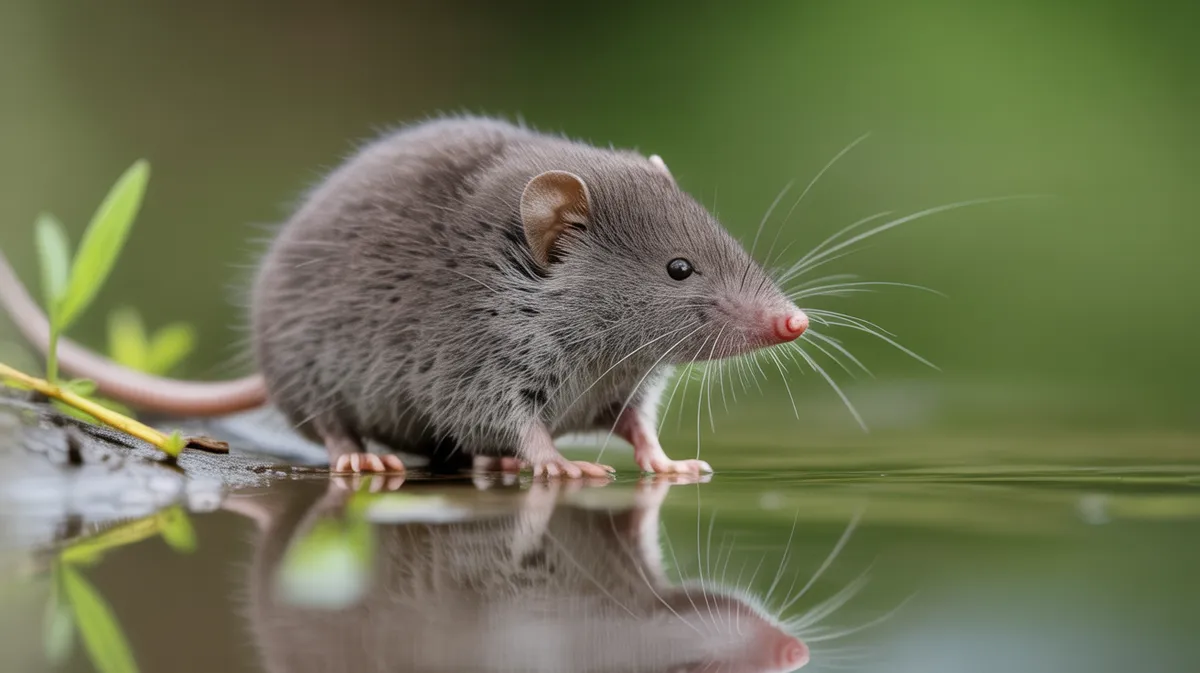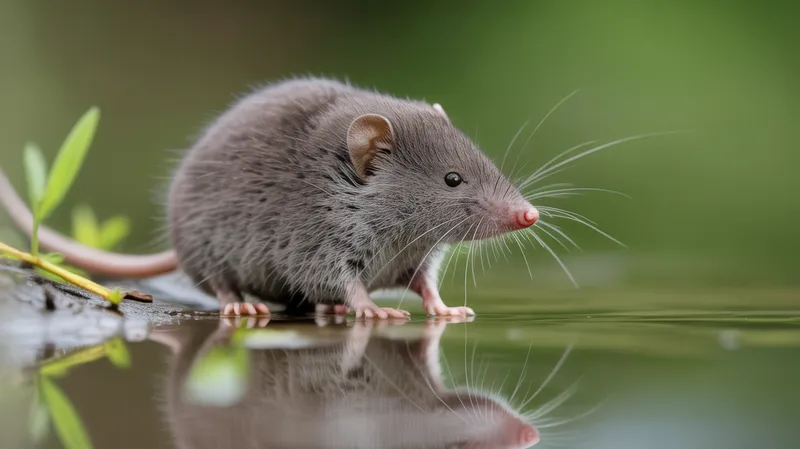
Poisonous Shrew
Neomys fodiens

Meet the Poisonous Shrew
The poisonous shrew, commonly known as the Eurasian water shrew, is a small, semi-aquatic mammal notable for its venomous bite. It has a dense, velvety black or dark brown fur with a contrasting whitish underbelly and a long, pointed snout. This shrew inhabits wetlands, riverbanks, and moist woodlands across Europe and parts of northern Asia. Its venom, delivered through grooves in its lower incisors, helps subdue prey much larger than itself, making it a formidable predator for its size.
Classification
Mammal
Habitat
Wetlands, riverbanks, moist forests
Diet
Carnivore
Lifespan
1.5-3 years
Conservation
Least Concern
Weight
12-18 grams
📖Fascinating Facts
Venomous Bite
The shrew delivers venom through grooves in its lower incisors, an unusual trait among mammals.
Aquatic Abilities
It is highly adapted for swimming, with fringed feet and a stiff-haired tail that help it move swiftly in water.
High Metabolism
The poisonous shrew must eat almost constantly, consuming up to its own body weight in food every 24 hours.
📋Detailed Description
The Eurasian water shrew (Neomys fodiens) is a robust, semi-aquatic insectivore measuring 8–10 cm in body length, with a tail of 6–8 cm, and weighing between 12–18 grams. Its dense, water-repellent fur is typically blackish or dark brown dorsally, sharply contrasting with a silvery or white ventral surface, and the tail is fringed with stiff hairs that aid in swimming. The elongated, mobile snout is packed with sensory vibrissae, enhancing prey detection underwater. Notably, Neomys fodiens possesses venomous submaxillary glands; the venom is delivered via grooves in the lower incisors, enabling it to immobilize and pre-digest prey, including aquatic invertebrates, small fish, amphibians, and even small mammals. The species is primarily crepuscular and nocturnal, exhibiting solitary and territorial behavior except during the breeding season. Water shrews construct complex burrow systems near water, with underwater entrances for predator avoidance and access to aquatic prey. Their metabolic rate is extremely high, necessitating frequent feeding—sometimes consuming up to 80–90% of their body weight daily. The species is well-adapted for aquatic life, with fringed feet and a laterally compressed tail for propulsion, and can remain submerged for up to 20 seconds. Lifespan in the wild is typically 18–24 months, with high juvenile mortality.
💡 Did you know?
Despite its small size, the poisonous shrew's venom is potent enough to kill frogs and even stun small fish.
🔬Research & Sources
🎭Behavior & Social Structure
Neomys fodiens is a solitary and highly territorial mammal, marking its territory with scent glands. It is primarily active during twilight and nighttime hours, alternating between foraging bouts and rest. The shrew is an opportunistic predator, using its acute sense of touch and underwater whiskers to locate prey, which it captures with rapid lunges. Its venomous bite allows it to subdue larger or more active prey, and it often caches excess food in its burrow. Water shrews are proficient swimmers and divers, frequently foraging underwater for aquatic insects, crustaceans, and small vertebrates. They exhibit aggressive encounters with conspecifics, especially outside the breeding season, and vocalize with high-pitched squeaks and clicks. Grooming is frequent to maintain fur waterproofing, and individuals spend considerable time maintaining burrow entrances and escape routes.
👶Reproduction & Life Cycle
Breeding in Neomys fodiens typically occurs from April to September, with peak activity in late spring and early summer. Females may produce 2–3 litters per year, each consisting of 4–8 young. Gestation lasts approximately 21–24 days. The nest, constructed in dry chambers within the burrow, is lined with grasses and moss. Young are born altricial (blind and hairless) and are cared for exclusively by the female. Weaning occurs at 3–4 weeks, after which juveniles disperse to establish their own territories. Sexual maturity is reached at around 8–10 months. Parental care is intense during the early weeks, with the mother frequently returning to nurse and groom the young.
🛡️Adaptations & Survival
Neomys fodiens exhibits several notable adaptations for its semi-aquatic lifestyle. Its dense, hydrophobic fur traps air, providing insulation and buoyancy. The tail is fringed with stiff hairs, increasing surface area for efficient swimming, while the hind feet are partially webbed. The shrew's venomous saliva, unique among European mammals, is an evolutionary specialization that allows it to immobilize and pre-digest prey, reducing handling time and risk of injury. Enhanced vibrissae and a highly developed sense of touch compensate for poor vision underwater. Its high metabolic rate supports rapid movement and frequent foraging, while physiological adaptations allow brief periods of apnea during dives.
📚Research Sources
🎨Cultural Significance
The Eurasian water shrew has limited direct significance in human culture, largely due to its secretive and nocturnal habits. However, its venomous bite has been noted in folklore and natural history accounts, sometimes leading to exaggerated tales of its danger. In some regions, shrews were historically associated with superstition, believed to possess magical or medicinal properties, though Neomys fodiens itself was rarely singled out. Its ecological role as a predator of aquatic invertebrates and small vertebrates is increasingly recognized in wetland conservation and biodiversity studies.
🔬Recent Research & Discoveries
Recent research has focused on the biochemical composition of Neomys fodiens venom, revealing the presence of kallikrein-like serine proteases and other unique proteins with potential pharmacological applications. Studies using stable isotope analysis have clarified its trophic position and seasonal dietary shifts. Ongoing ecological research investigates the impact of habitat fragmentation and water quality on population dynamics. Genetic studies are exploring population structure and connectivity across its range, with implications for conservation management. There is also growing interest in the shrew's role as a bioindicator for freshwater ecosystem health.
🎥Wildlife Videos

Psycho Shrew vs. Scorpion | Animal Fight Night
#NatGeoWILD #Shrews #Scorpions About Animal Fight Night: Animal Fight Night features same-species battles between some of ...
Nat Geo Animals

Tiny Water Shrews Are the "Cheetahs of the Wetlands"
A water shrew is an insectivore no bigger than a thumb but don't let its size fool you. Please LIKE and SUBSCRIBE if you enjoyed ...
Nature on PBS

Shrew vs. Snake | National Geographic
About National Geographic: National Geographic is the world's premium destination for science, exploration, and adventure.
National Geographic

Lethal Poison | Animal Armory | Episode 4 | Free Documentary Nature
Animal Armory - Episode 4: Lethal Poison | Animal Documentary Watch 'Animal Armory - Episode 5' here: ...
Free Documentary - Nature

Eurasian Water Shrew - The Tiny Predator | Full Documentary
Dive into the fascinating world of one of nature's smallest yet fiercest hunters. The Eurasian water shrew, a tiny mammal with an ...
Free High-Quality Documentaries

SHORT-TAILED SHREW - Nature's Tiny but Mighty Predator
Embark on a fascinating journey into the hidden world of the Short-Tailed Shrew with our captivating short documentary. Join us ...
BEASTFLIX
🌍Habitat Information
The Poisonous Shrew typically inhabits Wetlands, riverbanks, moist forests environments. Poisonous Shrews have adapted to their environments with specialized features and behaviors.
Primary Habitat:
Wetlands, riverbanks, moist forests
More detailed habitat information will be available soon.
🛡️Conservation Status
The Poisonous Shrew is currently classified as Least Concern. Conservation efforts are crucial for preserving this species for future generations.
Common Threats:
- 🏠Habitat loss and fragmentation
- 🌡️Climate change impacts
- 🎯Hunting and poaching
- 🏭Human-wildlife conflict
⚠️Threats & Conservation Challenges
Although currently listed as Least Concern by the IUCN, Neomys fodiens faces several localized threats. Habitat degradation from wetland drainage, riverbank modification, and pollution can reduce prey availability and suitable nesting sites. Pesticide runoff and water contamination may impact both the shrew and its invertebrate prey base. Fragmentation of aquatic habitats can isolate populations, increasing vulnerability to stochastic events. Predation by domestic cats, mustelids, and birds of prey is significant, especially in fragmented landscapes. Climate change poses a long-term threat by altering hydrological regimes and wetland distribution. Despite these challenges, the species remains widespread and resilient in much of its range.
🔬Scientific Classification
Scientific Name
Neomys fodiens
Classification Hierarchy
🔍 About Taxonomic Classification
Taxonomic classification is a hierarchical system used by scientists to classify and organize living organisms based on shared characteristics and evolutionary relationships.
The system moves from broad categories (Kingdom) to increasingly specific ones, with each animal's scientific name typically consisting of its Genus and species.
📝Community Notes
Share your observations and insights about the Poisonous Shrew with our community of wildlife enthusiasts.
Join Our Community
Sign in to share your observations and connect with fellow wildlife enthusiasts.
Sign In to ContributeNo community notes yet
Be the first to share your observations about the Poisonous Shrew!
Explore Poisonous Shrew
Select a tab above to learn more about this amazing animal.
📸Photo Gallery
No photos available for this animal yet.
🌟Discover More Wildlife
Continue your journey of discovery with more fascinating animals from our database
